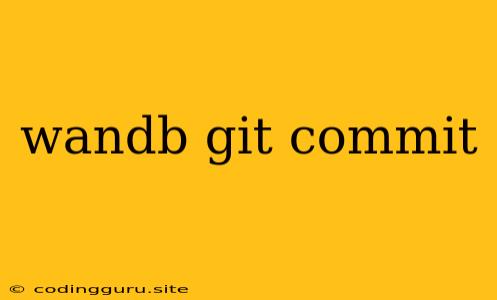Harnessing the Power of wandb and git for Seamless Experiment Tracking and Collaboration
In the world of machine learning, efficient experiment tracking and version control are paramount. wandb and git are two powerful tools that can revolutionize your workflow, ensuring reproducible results and collaborative development. This article will explore the seamless integration of these tools, highlighting the benefits and best practices for maximizing their impact.
Why wandb and git?
wandb (Weights & Biases) is a popular platform for experiment tracking, allowing you to monitor and compare your model's performance across different runs, hyperparameters, and datasets. git, a robust version control system, helps you manage code changes, track revisions, and collaborate effectively with others.
By combining wandb and git, you gain a comprehensive system that captures the full scope of your machine learning journey, from code to results. This integration empowers you to:
- Reproducible Research: Ensure that every step of your machine learning project is documented and reproducible.
- Collaborative Development: Share your code, experiments, and findings with your team, fostering a seamless collaborative environment.
- Efficient Debugging: Quickly identify and fix errors by tracing back changes in your code and corresponding experiment results.
- Data Versioning: Keep track of your datasets and their evolution, ensuring that your models are trained on the correct data versions.
wandb and git in Action: A Practical Guide
Let's explore how to integrate wandb and git effectively in your workflow.
1. Setting up Your Environment
-
Git Installation: Ensure you have Git installed on your system. You can find instructions and download links on the official Git website.
-
wandb Installation: Install the wandb library using pip:
pip install wandb -
wandb Configuration: Sign up for a wandb account and set up your project. This will generate an API key for logging your experiments.
2. Initiating Your Project
-
Git Initialization: Create a new Git repository for your project.
git init -
wandb Integration: Add wandb to your project by initializing a new wandb run:
import wandb wandb.init(project="my-project")
**3. Tracking Experiments with wandb
-
Log Metrics: Log key metrics like accuracy, loss, and other relevant data using wandb.log():
wandb.log({"accuracy": accuracy, "loss": loss}) -
Log Parameters: Log hyperparameters and configuration details using wandb.config:
wandb.config.update({"learning_rate": 0.01, "batch_size": 32}) -
Log Artifacts: Store and track model weights, datasets, or other artifacts using wandb.save():
wandb.save("model.h5")
**4. Committing Changes with git
-
Staging Changes: Add files to the staging area using git add:
git add . -
Committing Changes: Commit your staged changes with a descriptive message using git commit:
git commit -m "Add wandb integration to project"
5. Pushing Changes to a Remote Repository
-
Remote Repository Creation: Create a remote repository on a platform like GitHub or GitLab.
-
Pushing Changes: Push your local commits to the remote repository using git push:
git push origin main
wandb and git Best Practices
- Descriptive Commit Messages: Write clear and concise commit messages that accurately describe the changes you've made.
- Frequent Commits: Commit your changes frequently to maintain a detailed history of your project.
- Branching Strategy: Use Git branches to develop new features or experiment with different ideas.
- Clean Code: Follow best practices for code style and structure to ensure readability and maintainability.
- Documentation: Document your code, experiments, and findings to facilitate collaboration and understanding.
wandb and git Integration: Beyond the Basics
- wandb Sweeps: Use wandb sweeps to automatically run experiments with different hyperparameter configurations.
- wandb Artifacts: Store and manage large datasets, model weights, and other files efficiently.
- wandb Tables: Analyze and visualize experimental results with powerful tables and charts.
- Git Hooks: Integrate wandb into your Git workflow using hooks to automatically log experiments.
Conclusion
The integration of wandb and git offers a powerful and comprehensive approach to experiment tracking and version control in machine learning. By embracing these tools, you gain the ability to optimize your workflow, enhance collaboration, and ensure reproducible results. Implement the best practices outlined in this article to unlock the full potential of these powerful tools and streamline your machine learning development journey.
